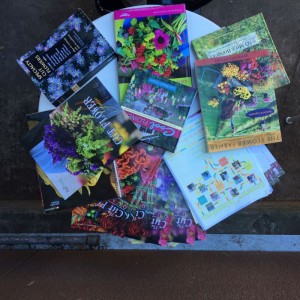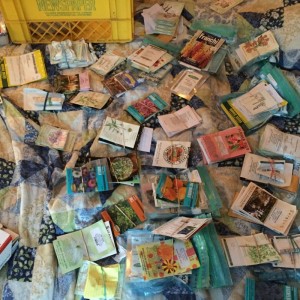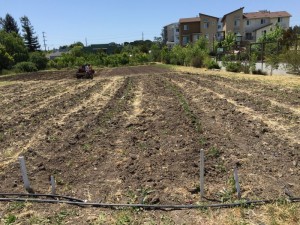Happy New Year everyone! Last time on the blog I let you in on some of my early winter work as a farmer. This week we’re continuing in that vein with the next steps of what farmers do in the winter – figuring out how many successions to grow of certain crops, how to rotate them through the farm to deter pests and disease, and how to learn a little more about your soil needs through annual testing.
What farmers do in the winter: succession planting
After deciding what to plant, the next step is to figure out how long each crop will produce. If I plant one zinnia plant on June 1st, it may flower by July 15th and keep flowering until September 1st. So if I want zinnias flowering on my farm into November, I’m going to need to plant more than one succession.
To figure out how many successions I need and when I should seed and transplant them, there are a few places I turn for information. First, I outline what I need to know:
- the date I seeded a plant
- the date it got in the ground
- the date it started flowering
- the last date it was flowering
The best source is always going to be notes from my farm journal (and we talked last time about the importance of keeping good records). Sometimes I was smart and recorded all of the information I need. Other times, and this is the more likely scenario, I have to piece together information and use some informed guessing. For example, I may have recorded the date that I seeded a tray of scabiosa in the greenhouse, but not the date that I transplanted it to the field. So I estimate that date to be 7 weeks after the seeding date (it was probably ready to go out after 6, but I’m never on schedule!). And then I didn’t note the date of the first flower, but I’m sure I was so excited about it that I captured some pictures of it! So I track those down and note the date. To figure out the last date it was flowering, and therefore the date I would need the next succession to begin flowering, I can check my sales receipts to find the date I last sold a bunch of scabiosa.

For succession planting in the home garden, the process will be a bit easier. Did you have enough lettuce all season long? Did your kale die out early and you were left kale-less for a month until the next round was big enough? Try to remember these details and move your planting dates around accordingly.
We’ll talk more on the blog about the ins and outs of starting seeds a little later. At this point in the season, I’m only starting a few select seeds that take particularly long to germinate and grow on. In my case, this includes select perennial flowers, annual lisianthus, and a few peppers for an early succession. For the home gardener, chances are you won’t need to dig into seed starting until a little later into winter.

What farmers do in the winter: drafting field maps
Figuring out where your plants should go each year is a tricky endeavor. It’s a good idea to have a solid grasp on crop rotation, even in small spaces. In very simple terms, you should grow different plants in different spaces every year if you can, and focus on 3-year cycles. If I planted broccoli in one spot last year, I’ll plant it somewhere different this year, and somewhere different from that again next year. The main idea behind crop rotation is that certain crops (and families of crops) attract certain pests and diseases, and draw the same type of nutrients out of the same layer of soil. By moving them around each season, you are changing things up with the intention of tricking the pests, warding off disease, and extracting a variety of nutrients from a greater range of soil depths.

At Petaluma Bounty, where we grow vegetables, there are a number of pretty small fields, so figuring out the field map is always a challenge. I start with the solanums – the peppers and tomatoes – because I plant each out in a huge block. I look at past years’ notes to jog my memory of where they were planted and then make a plan from there.
At B-Side Farm, where I grow flowers exclusively, I’m a little more lenient. Many of the flowers I grow are in the same families and don’t differ from one another as drastically as many of the vegetables I grow. When in doubt, I move varieties around as much as possible year-to-year.
It’s not always easy, especially in small gardens and tight spaces. I recommend that you simply do the best you can and don’t worry too much about it if you realize that you’ve made a crop rotation faux pas. Adhering to other best management practices for sustainable production – such as incorporating cover crops, building your soil, and applying compost – will also help you to achieve these ends.
What farmers do in the winter: soil testing
It’s hard to know exactly what’s going on in your soil, but there are many things you can tell just by observing. When you stick your hand into the soil, is it soft, loose and airy, or rocky and hard? Are there earthworms? Does it hold water well, or does water drain right through it? Did your plants thrive in it last season?
Down the road on the blog we’re dig into soil chemistry and biology, but for now I’ll leave you with a quick note about the importance of doing a complete soil test to see what nutrients are present and what are lacking.
Every spring I take a soil sample from every field and send it off to A & L Labs to have it assessed. The test lets me know what’s present, what’s lacking, and suggests what I can do to improve it. For example, my tests always come back saying that my organic matter content is slightly less than ideal, meaning that I should add compost and grow a round of cover crop (two things I had already planned on). But there is also lots of great information I wouldn’t have known – the calcium to magnesium ratio and what that means for my plants, the pH, and so on and so forth. Having your soil tested is a great way to start learning about what is really going on below the ground. Do it!
Next time on the blog we’ll be jumping into an interview with local farm-to-table chef Matt Elias of Saltwater Oyster Depot. Matt takes care to source only freshest produce from stellar local farmers and can tell us first-hand how all this care and attention to crop production leads to some of the best dishes around.







 Family
Family

